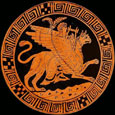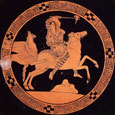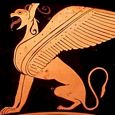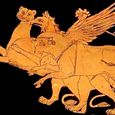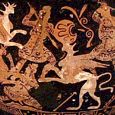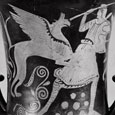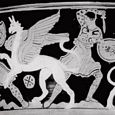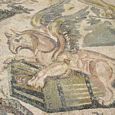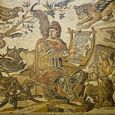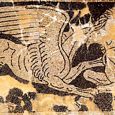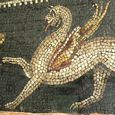GRYPS
Greek Name
Γρυψ Γρυπες Γρυφοι
Transliteration
Gryps, Grypes, Gryphoi
Latin Spelling
Gryps, Gryphis, Gryphi
Translation
Griffin, Griffins
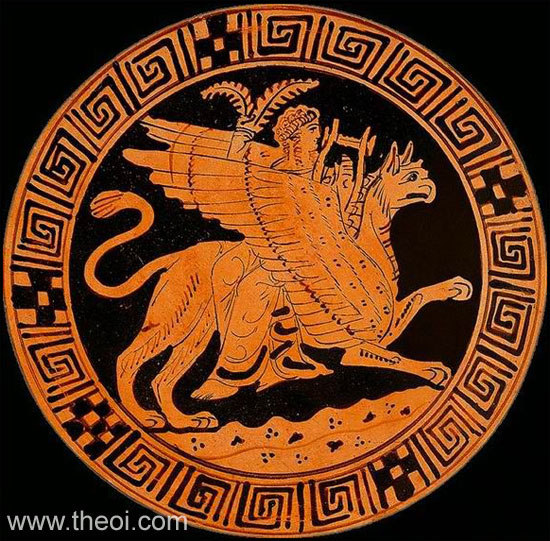
THE GRYPS (Griffin) was a beast with the head and wings of an eagle and the body of a lion.
A tribe of the creatures guarded rich deposits of gold in the mountains of Skythia (Scythia) in north-eastern Europe. Their one-eyed neighbours, the Arimaspians, battled them for these riches.
Decorative griffins were popular in ancient Greek art and later in medieval bestiaries and heraldry.
ENCYCLOPEDIA
GRYPS or GRYPHUS (Grups), a griffin, a fabulous, bird-like species of animals, dwelling in the Rhipaean mountains, between the Hyperboreans and the one-eyed Arimaspians, and guarding the gold of the north. The Arismaspians mounted on horseback, and attempted to steal the gold, and hence arose the hostility between the horse and the griffin. The body of the griffin was that of a lion, while the head and wings were those of an eagle. This monstrous conception suggests that the origin of the belief in griffins must be looked for in the east, where it seems to have been very ancient. (Herod. iii. 116, iv. 13, 27; Paus. i. 24. § 6. viii. 2, § 3; Aelian, H. A. iv. 27; Plin. H. N. vii. 2, x. 70.) Hesiod seems to be the first writer that mentioned them, and in the poem "Arimaspae " of Aristeas they must have played a prominent part. (Schol. ad Aeschyl. Prom. 793.) At a later period they are mentioned among the fabulous animals which guarded the gold of India. (Philostr. Vit. Apollon. iii. 48.) The figures of griffins were frequently employed as ornaments in works of art ; the earliest instance of which we have any record is the bronze patera, which the Samians ordered to be made about B. C. 640. (Herod. iv. 152; comp. 79.) They were also represented on the helmet of the statue of Athena by Phidias. (Paus. l. c.)
Source: Dictionary of Greek and Roman Biography and Mythology.
CLASSICAL LITERATURE QUOTES
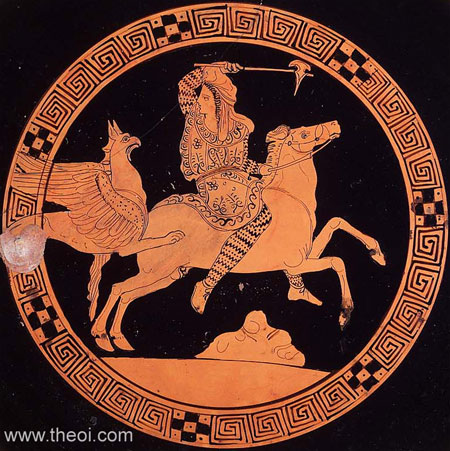
Aeschylus, Prometheus Bound 802 ff (trans. Weir Smyth) (Greek tragedy C5th B.C.)
:
"[Prometheus warns the wandering Io :] ‘But now listen to another and a fearsome spectacle. Beware of
the sharp-beaked hounds of Zeus that do not bark, the Grypes (Griffins), and the one-eyed
(monôpoi) Arimaspoi (Arimaspians), mounted on horses, who dwell about the flood of Plouton's
(Pluton's) stream that flows with gold. Do not approach them.’"
Aristophanes, Frogs 929 825 (trans. O'Neill) (Greek comedy C5th to 4th B.C.)
:
"Euripides : 'Twas all Skamandros (Scamander), moated camps, and Grypaietoi (Griffin-Eagles) flashing in
burnished copper on the shields."
Herodotus, Histories 3. 116. 1 (trans. Godley) (Greek historian C5th B.C.)
:
"But in the north of Europe there is by far the most gold. In this matter again I cannot say with assurance
how the gold is produced, but it is said that one-eyed men called Arimaspoi (Arimaspians) steal it from Grypes
(Griffins). The most outlying lands, though, as they enclose and wholly surround all the rest of the world,
are likely to have those things which we think the finest and the rarest."
Herodotus, Histories 4. 13. 1 :
"There is also a story related in a poem by Aristeas son of Kaüstrobios, a man of Prokonnesos
(Proconnesus). This Aristeas, possessed by Phoibos (Phoebus) [Apollon], visited the Issedones; beyond these (he
said) live the one-eyed Arimaspoi (Arimaspians), beyond whom are the Grypes (Griffins) that guard gold, and
beyond these again the Hyperboreoi (Hyperboreans), whose territory reaches to the sea. Except for the
Hyperboreoi, all these nations (and first the Arimaspoi) are always at war with their neighbors; the Issedones
were pushed from their lands by the Arimaspoi, and the Skythians (Scythians) by the Issedones."
Herodotus, Histories 4. 27. 1 :
"Of these too, then, we have knowledge; but as for what is north of them, it is from the Issedones that the
tale comes of the one-eyed men [Arimaspoi (Arimaspians)] and the Grypes (Griffins) that guard gold; this is told
by the Skythians (Scythians), who have heard it from them; and we have taken it as true from the Skythians, and
call these people by the Skythian name, Arimaspoi; for in the Skythian tongue arima is
‘one’, and spou is the ‘eye’."
Herodotus, Histories 4. 79. 1 :
"He had in the city of the Borysthenites [in Asia Minor] a spacious house, grand and costly (the same house
I just mentioned), all surrounded by Sphinxes and Grypes (Griffins) worked in white marble."
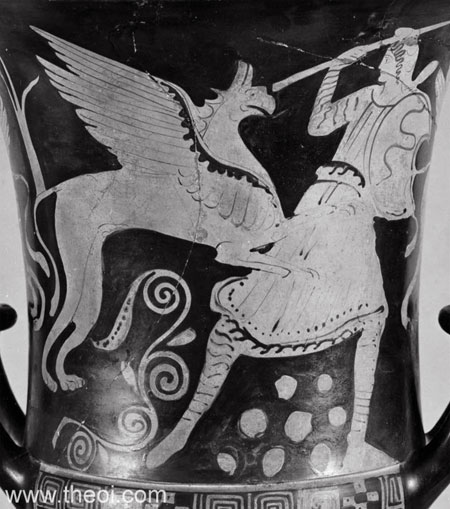
Herodotus, Histories 4. 152. 4 :
"The Samians took six talents, a tenth of their profit, and made a bronze vessel with it, like an Argolic
cauldron, with Grypes' (Griffins') heads projecting from the rim all around; they set this up in their temple of
Hera, supporting it with three colossal kneeling figures of bronze, each twelve feet high."
Ctesias, Indica (summary from Photius, Myriobiblon 72) (trans. Freese) (Greek
historian C4th B.C.) :
"There is also gold [in India], not found in rivers and washed, as in the river Paktolos (Pactolus) [in
Lydia], but in many large mountains which are inhabited by Grypes (Griffins). These are four-footed birds as
large as a wolf, their legs and claws resembling those of a lion; their breast feathers are red, those of the
rest of the body black. Although there is abundance of gold in the mountains, it is difficult to get it because
of these birds."
Strabo, Geography 8. 3. 12 (trans. Jones) (Greek geographer C1st B.C. to C1st A.D.)
:
"Near the outlet of the river [the River Alpheios in Elis] is the sacred precinct of Artemis Alpheionia . .
. In the temple of Artemis Alpheionia are very famous paintings . . . by Aregon the ‘Artemis Borne Aloft
on a Gryps (Griffin).’"
Pausanias, Description of Greece 1. 24. 6 (trans. Jones) (Greek travelogue C2nd A.D.)
:
"Grypas (Griffins), Aristeas of Prokonnesos says in his poem, fight for the gold with the Arimaspoi
(Arimaspians) beyond the Issedones. The gold which the Grypas guard, he says, comes out of the earth; the
Arimaspoi are men all born with one eye; Grypas are beasts like lions, but with the beak and wings of an
eagle."
Pausanias, Guide to Greece 8. 2. 7 :
"I have also heard that Gryphoi (Griffins) have spots like the leopard."
Pausanias, Guide to Greece 1. 31. 2 :
"At Prasiai (Prasiae) [in Attika] is a temple of Apollon. Hither they say are sent the first-fruits of the
Hyperboreoi (Hyperboreans), and the Hyperboreoi are said to hand them over to the Arimaspoi (Arimaspians), the
Arimaspoi to the Issedones, from these the Skythians (Scythians) bring them to Sinope, thence they are carried
by Greeks to Prasiai, and the Athenians take them to Delos."
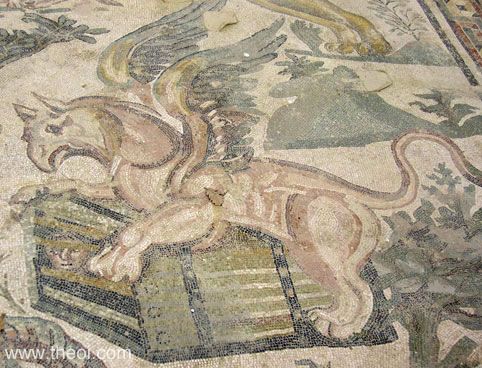
Aelian, On Animals 4. 27 (trans. Scholfield) (Greek natural history C2nd A.D.)
:
"I have heard that the Indian animal the Grupa (Gryphon, Griffin) is a quadraped like a lion; that it has
claws of enormous strength and that they resemble those of a lion. Men commonly report that it is winged and
that the feathers along its back are black, and those on its front are red, while the actual wings are neither
but are white. And Ktesias (Ctesias) records that its neck is variegated with feathers of a dark blue; that it
has a beak like an eagle's, and a head too, just as artists portray it in pictures and sculpture. Its eyes, he
says, are like fire. It builds its lair among the mountains, and although it is not possible to capture the
full-grown animal, they do take the young ones. And the people of Baktria (Bactria), who are neighbours of the
Indians, say that the Grypes (Gryphons) guard the gold in those parts; that they dig it up and build their nests
with it, and that the Indians carry off any that falls from them. The Indians however deny that they guard the
aforesaid gold, for the Grypes have no need for it--and if that is what they say, then I at any rate think that
they speak the truth--, but that they themselves come to collect the gold, while the Grypes fearing for their
young ones fight with the invaders. They engage too with other beasts and overcome them without difficulty, but
they will not face the lion or the elephant. Accordingly the natives, dreading the strength of these animals, do
not set out in quest of the gold by day, but arrive by night, for at that season they are less likely to be
detected.
Now the region where the Grypes live and where the gold is mined is a dreary wilderness. And the seekers after
the aforesaid substance arrive, a thousand or two strong, armed and bringing spades and sacks; and watching for
a moonless night they begin to dig. Now if they contrive to elude the Grypes they reap a double advantage, for
they not only escape with their lives but they also take home their freight, and when those who have acquired a
special skill in the smelting of gold have refined it, they possess immense wealth to requite them for the
dangers described above. And they return home, I am told, after an interval of three or four years."
Philostratus, Life of Apollonius of Tyana 3. 48 (trans. Conybeare) (Greek biography
C1st to C2nd A.D.) :
"As to the gold which the Grypes (Griffins) dig up, there are rocks which are spotted with drops of gold as
with sparks, which this creature can quarry because of the strength of its beak.
‘For these animals do exist in India,’ he [the Indian sage Iarkhas (Iarchas), C1st A.D.] said,
‘and are held in veneration as being sacred to Helios the Sun; and the Indian artists, when they represent
Helios, yoke four of them abreast to draw the images; and in size and strength they resemble lions but having
this advantage over them that they have wings, they will attack them, and they get the better of elephants and
of Drakones (Dragon-Serpents). But they have no great power of flying, not more than have birds of short flight;
for they are not winged as is proper with birds, but the palms of their feet are webbed with red membranes, such
that they are able to revolve them, and make a flight and fight in the air; and the tiger alone is beyond their
powers of attack, because in swiftness it rivals the winds.’"
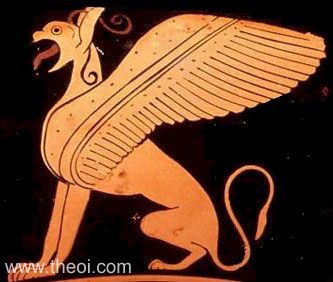
Philostratus, Life of Apollonius of Tyana 6. 1 :
"And the Grypes (Griffins) of the Indoi (Indians) and the Ants of the Aithiopes (Ethiopians), though they
are dissimilar in form, yet, from what we hear, play similar parts; for in each country they are, according to
the tales of poets, the guardians of gold, and devoted to the gold reefs of the two countries."
Pliny the Elder, Natural History 7. 10 (trans. Rackham) (Roman encyclopedia C1st
A.D.) :
"Also a tribe is reported next to these [i.e. the tribes of Skythia (Scythia)], towards the North, not far
from the actual quarter where Aquilo (the North Wind) [Boreas] rises and the cave that bears its name, the place
called the Earth's Door-Bolt (Ges Clithron)--the Arimaspi (Arimaspians) whom we have spoke of already,
people remarkable for having one yes in the centre of their forehead. Many authorities, the most distinguished
being Herodotus [Greek historian C5th B.C.] and Aristeas of Proconnesus [Greek poet C7th B.C.], write that these
people wage continual war with the Grypes (Griffins), a kind of wild beast with wings, as commonly reported,
that digs gold out of mines, which the creatures guard and the Arimaspi try to take from them, both with
remarkable covetousness."
Apuleius, The Golden Ass 11. 235 ff (trans. Walsh) (Roman novel C2nd A.D.) :
"Hyperborei Grypes (Hyperborean Griffins) which look like winged birds and are produced in another
world."
Nonnus, Dionysiaca 48. 395 ff (trans. Rouse) (Greek epic C5th A.D.) :
"Round her [Nemesis the goddess of retribution's] throne flew a bird of vengeance, a Gryps (Griffin) flying
with wings, or balancing himself on four feet, to go unbidden before the flying goddess and show that she
herself traverses the four separate quarters of the world."
Nonnus, Dionysiaca 48. 449 ff :
"She [Nemesis] had harnessed racing Grypes (Griffins) under her bridle; quick through the air she coursed
in the swift car, until she tightened the curving bits of her fourfooted birds, and drew up on the peak of
Sipylos in front of the face of Tantalos' daughter [Niobe] with eyeballs of stone."
ANCIENT GREEK & ROMAN ART
SOURCES
GREEK
- Aeschylus, Prometheus Bound - Greek Tragedy C5th B.C.
- Aristophanes, Frogs - Greek Comedy C5th - 4th B.C.
- Herodotus, Histories - Greek History C5th B.C.
- Ctesias, Indica - Greek History C5th B.C.
- Strabo, Geography - Greek Geography C1st B.C. - C1st A.D.
- Pausanias, Description of Greece - Greek Travelogue C2nd A.D.
- Aelian, On Animals - Greek Natural History C2nd - 3rd A.D.
- Philostratus, Life of Apollonius of Tyana - Greek Biography C2nd A.D.
- Nonnus, Dionysiaca - Greek Epic C5th A.D.
ROMAN
- Pliny the Elder, Natural History - Latin Encyclopedia C1st A.D.
- Apuleius, The Golden Ass - Latin Novel C2nd A.D.
BYZANTINE
- Photius, Myriobiblon - Byzantine Greek Scholar C9th A.D.
BIBLIOGRAPHY
A complete bibliography of the translations quoted on this page.
